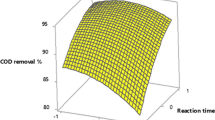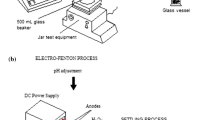Abstract
Dairy wastewater contains high levels of organic matter that would be a serious threat if being discharged to the environment without any treatment. This study investigated the influence of various parameters including the concentration of poly aluminum chloride (PAC) on the chemical coagulation process and the concentration of H2O2, pH of the solution, reaction time, voltage and distance of electrodes in the electro-Fenton (EF) process. The optimum conditions obtained in this study included PAC concentration of 100 mg/L, pH of 3, reaction time of 60 min, voltage of 20 V, H2O2 concentration of 1.5 g/L and electrode distance of 2 cm. This resulted in the removal efficiency of 90.3%, 87.25%, and 87% for chemical oxygen demand (COD), biochemical oxygen demand (BOD5), and total suspended solids, respectively. The estimated cost of the process in terms of 1 kg COD removal was about $1.16. Two experimental models, called the feed-forward artificial neural network (FF-ANN) and partial least squares (PLS), were developed to predict the behavior of the process in COD removal. The results confirmed that both FF-ANN and PLS were powerful tools in predicting COD removal in the EF process, as the correlation coefficients between the predicted COD and the actual COD for the PLS and FF-ANN models were 0.854 and 0.971, respectively. Sensitivity analysis of both models showed that the reaction time and electrode distance had the most influence on the output of PLS and FF-ANN, respectively. Therefore, this combined process can be regarded as a thought-provoking one for dairy wastewater treatment, and the FF-ANN model was a more powerful tool than the PLS one.













Similar content being viewed by others
References
Ahmad T et al (2019) Treatment and utilization of dairy industrial waste: a review. Trends Food Sci Technol 88:361–372. https://doi.org/10.1016/j.tifs.2019.04.003
Akbari S, Ghanbari F, Moradi M (2016) Bisphenol A degradation in aqueous solutions by electrogenerated ferrous ion activated ozone, hydrogen peroxide and persulfate: applying low current density for oxidation mechanism. Chem Eng J 294:298–307. https://doi.org/10.1016/j.cej.2016.02.106
Akyol A, Can OT, Demirbas E, Kobya M (2013) A comparative study of electrocoagulation and electro-Fenton for treatment of wastewater from liquid organic fertilizer plant. Sep Purif Technol 112:11–19
Alimoradi S, Faraj R, Torabian A (2018) Effects of residual aluminum on hybrid membrane bioreactor (Coagulation-MBR) performance, treating dairy wastewater. Chem Eng Process Process Intensif 133:320–324
APHA (2005) Standard Method For The Examination of Water and Wastewater. American Public Health Association, Washington, DC
Askari H, Ghaedi M, Dashtian K, Azghandi MHA (2017) Rapid and high-capacity ultrasonic assisted adsorption of ternary toxic anionic dyes onto MOF-5-activated carbon: artificial neural networks, partial least squares, desirability function and isotherm and kinetic study. Ultrason Sonochem 37:71–82
Asselin M, Drogui P, Benmoussa H, Blais J-F (2008) Effectiveness of electrocoagulation process in removing organic compounds from slaughterhouse wastewater using monopolar and bipolar electrolytic cells. Chemosphere 72:1727–1733
Atmaca E (2009) Treatment of landfill leachate by using electro-Fenton method. J Hazard Mater 163:109–114. https://doi.org/10.1016/j.jhazmat.2008.06.067
Babuponnusami A, Muthukumar K (2012) Advanced oxidation of phenol: a comparison between Fenton, electro-Fenton, sono-electro-Fenton and photo-electro-Fenton processes. Chem Eng J 183:1–9
Bao T, Damtie MM, Hosseinzadeh A, Frost RL, Yu ZM, Jin J, Wu K (2020a) Catalytic degradation of P-chlorophenol by muscovite-supported nano zero valent iron composite: Synthesis, characterization, and mechanism studies. Appl Clay Sci 195:105735. https://doi.org/10.1016/j.clay.2020.105735
Bao T et al (2020b) Bentonite-supported nano zero-valent iron composite as a green catalyst for bisphenol A degradation: preparation, performance, and mechanism of action. J Environ Manag 260:110105. https://doi.org/10.1016/j.jenvman.2020.110105
Bartram JBR (2010) A practical guid to the design and implementation of freshwater quality studies and monitoring programmes. Shasoosa Publisher, Kashan, Iran
Baziar M et al (2017) MWCNT-Fe3O4 as a superior adsorbent for microcystins LR removal: Investigation on the magnetic adsorption separation, artificial neural network modeling, and genetic algorithm optimization. J Mol Liq 241:102–113
Baziar M, Nabizadeh R, Mahvi AH, Alimohammadi M, Naddafi K, Mesdaghinia A, Aslani H (2018a) Effect of dissolved oxygen/nZVI/persulfate process on the elimination of 4-chlorophenol from aqueous solution: Modeling and optimization study Korean. J Chem Eng 35:1128–1136
Baziar M, Nabizadeh R, Mahvi AH, Naddafi K, Mesdaghinia A, Alimohammadi M, Aslani H (2018b) Sensitivity analysis and modeling of 4-chlorophenol degradation in aqueous solutions by an nZVI-sodium persulfate system. Desalin Water Treat 112:292–302
Beltrán-Heredia J, Sánchez-Martín J, Dávila-Acedo M (2011) Optimization of the synthesis of a new coagulant from a tannin extract. J Hazard Mater 186:1704–1712
Brillas E, Mur E, Sauleda R, Sanchez L, Peral J, Domenech X, Casado J (1998) Aniline mineralization by AOP’s: anodic oxidation, photocatalysis, electro-Fenton and photoelectron-Fenton processes. Appl Catal 16:31–42
Brillas E, Sirés I, Oturan MA (2009) Electro-fenton process and related electrochemical technologies based on fenton’s reaction chemistry. Chem Rev 109:6570–6631. https://doi.org/10.1021/cr900136g
Cansado IPP, Mourão PAM, Falcão AI, Carrott MMLR, Carrott PJM (2012) The influence of the activated carbon post-treatment on the phenolic compounds removal. Fuel Process Technol 103:64–70. https://doi.org/10.1016/j.fuproc.2011.10.015
Chandra R, Castillo-Zacarias C, Delgado P, Parra-Saldívar R (2018) A biorefinery approach for dairy wastewater treatment and product recovery towards establishing a biorefinery complexity index. J Clean Prod 183:1184–1196
Chen G, Talebi S, Gras S, Weeks M, Kentish S (2018) A review of salty waste stream management in the Australian dairy industry. J Environ Manage 224:406–413
Chiou CS (2007) Application of steel waste with UV/H2O2 to mineralize 2-naphthalenesulfonate in aqueous solution. Sep Purif Technol 55:110–116
Dela Justina M (2018) Rodrigues Bagnolin Muniz B, Mattge Bröring M, Costa VJ, Skoronski E. Using vegetable tannin and polyaluminium chloride as coagulants for dairy wastewater treatment: A comparative study Journal of Water Process Engineering 25:173–181. https://doi.org/10.1016/j.jwpe.2018.08.001
Ganju S, Gogate PR (2017) A review on approaches for efficient recovery of whey proteins from dairy industry effluents. J Food Eng 215:84–96
Ghosh P, Samanta AN, Ray S (2011) Reduction of COD and removal of Zn 2+ from rayon industry wastewater by combined electro-Fenton treatment and chemical precipitation. Desalination 266:213–217
Hosseinzadeh A, Baziar M, Alidadi H, Zhou JL, Altaee A, Najafpoor AA, Jafarpour S (2020a) Application of artificial neural network and multiple linear regression in modeling nutrient recovery in vermicompost under different conditions. Biores Technol 303:122926. https://doi.org/10.1016/j.biortech.2020.122926
Hosseinzadeh A, Najafpoor AA, Jafari AJ, Jazani RK, Baziar M, Bargozin H, Piranloo FG (2018) Application of response surface methodology and artificial neural network modeling to assess non-thermal plasma efficiency in simultaneous removal of BTEX from waste gases: effect of operating parameters and prediction performance. Process Saf Environ Prot 119:261–270
Hosseinzadeh A, Zhou JL, Altaee A, Baziar M, Li D (2020b) Effective modelling of hydrogen and energy recovery in microbial electrolysis cell by artificial neural network and adaptive network-based fuzzy inference system. Bioresour Technol. https://doi.org/10.1016/j.biortech.2020.123967
Hosseinzadeh A, Zhou JL, Altaee A, Baziar M, Li X (2020c) Modeling water flux in osmotic membrane bioreactor by adaptive network-based fuzzy inference system and artificial neural network. Biores Technol 310:123391. https://doi.org/10.1016/j.biortech.2020.123391
Jaganmai G, Jinka R (2017) Production of lipases from dairy industry wastes and its applications. Int J Curr Microbiol Appl Sci 2017:67–73
Ji B, Yang K, Wang H (2015) Impacts of poly-aluminum chloride addition on activated sludge and the treatment efficiency of SBR. Desalin Water Treat 54:2376–2381
Kheirieh S, Asghari M, Afsari M (2018) Application and modification of polysulfone membranes. Rev Chem Eng 34:657–693
Kushwaha JP, Srivastava VC, Mall ID (2011) An overview of various technologies for the treatment of dairy wastewaters. Crit Rev Food Sci Nutr 51:442–452
Lenore S, Clesceri AEG, Eaton AD (2005) Standard method for the examination of water and wastewater. American Public Health Association, America
Lou Y-Y, Geneste F, Soutrel I, Amrane A, Fourcade F (2020) Alachlor dechlorination prior to an electro-Fenton process: influence on the biodegradability of the treated solution. Sep Purif Technol 232:115936. https://doi.org/10.1016/j.seppur.2019.115936
Martínez-Huitle CA, Rodrigo MA, Sirés I, Scialdone O (2015) Single and coupled electrochemical processes and reactors for the abatement of organic water pollutants: a critical review. Chem Rev 115:13362–13407. https://doi.org/10.1021/acs.chemrev.5b00361
Mazloomi S, Zarei A, Nourmoradi H, Ghodsei S, Amraei P, Haghighat GA (2019) Optimization of coagulation-flocculation process for turbidity removal using response surface methodology: a study in Ilam water treatment plant, Iran. Iran Desalin Water Treat 147:234–242
Mollah MYA, Schennach R, Parga JR, Cocke DL (2001) Electrocoagulation(EC)—science and applications. J Hazardous Mater 84:24–41
Najafpoor AA, Jafari AJ, Hosseinzadeh A, Jazani RK, Bargozin H (2018) Optimization of non-thermal plasma efficiency in the simultaneous elimination of benzene, toluene, ethyl-benzene, and xylene from polluted airstreams using response surface methodology. Environ Sci Pollut Res 25:233–241
Najafpoor AA et al (2015) Biodegradation of high concentrations of phenol by baker’s yeast in anaerobic sequencing batch reactor. Environ Health Eng Manag J 2:79–86
Nidheesh PV, Gandhimathi R (2012) Trends in electro-Fenton process for water and wastewater treatment: an overview. Desalination 299:1–15. https://doi.org/10.1016/j.desal.2012.05.011
Popat A, Nidheesh PV, Anantha Singh TS, Suresh Kumar M (2019) Mixed industrial wastewater treatment by combined electrochemical advanced oxidation and biological processes. Chemosphere 237:124419. https://doi.org/10.1016/j.chemosphere.2019.124419
Porwal H, Mane A, Velhal S (2015) Biodegradation of dairy effluent by using microbial isolates obtained from activated sludge. Water Resour Ind 9:1–15
Sinha S, Yoon Y, Amy G, Yoon J (2004) Determining the effectiveness of conventional and alternative coagulants through effective characterization schemes. Chemosphere 57:1115–1122
Sirés I, Brillas E (2012) Remediation of water pollution caused by pharmaceutical residues based on electrochemical separation and degradation technologies: A review. Environ Int 40:212–229. https://doi.org/10.1016/j.envint.2011.07.012
Sirés I, Brillas E, Oturan M, Rodrigo M, Panizza M (2014) Electrochemical advanced oxidation processes: today and tomorrow. A review. Environ Sci Pollut Res 21:8336–8367
Umar M, Aziz HA, Yusoff MS (2010) Trends in the use of Fenton, electro-Fenton and photo-Fenton for the treatment of landfill leachate. Waste Manag 30:2113–2121
Wang Q, Lemley AT (2001) Kinetic model and optimization of 2, 4-D degradation by anodic Fenton treatment. Environ Sci Technol 35:4509–4514
Yang Z, Gao B, Yue Q (2010) Coagulation performance and residual aluminum speciation of Al2 (SO4) 3 and polyaluminum chloride (PAC) in Yellow River water treatment. Chem Eng J 165:122–132
Yin C-Y (2010) Emerging usage of plant-based coagulants for water and wastewater treatment. Process Biochem 45:1437–1444
Yonar T, Sivrioğlu Ö, Özengin N (2018) Physico-chemical treatment of dairy industry wastewaters: a review technological approaches for novel applications in dairy. Processing 2018:179
Zelmanov G, Semiat R (2008) Iron (3) oxide-based nanoparticles as catalysts in advanced organic aqueous oxidation. Water Res 42:492–498
Zhang H, Choi HJ, Huang C-P (2005) Optimization of Fenton process for the treatment of landfill leachate. J Hazard Mater 125:166–174
Zhang H, Fei C, Zhang D, Tang F (2007) Degradation of 4-nitrophenol in aqueous medium by electro-Fenton method. J Hazardous Mater 145:227–232
Acknowledgements
The current work was funded by a grant (Project No.: 4358) from the Birjand University of Medical Sciences (BUMS), Birjand, Iran.
Author information
Authors and Affiliations
Corresponding author
Ethics declarations
Conflict of interest
The authors of this article declare that they have no conflict of interests.
Additional information
Editorial responsibility: Josef Trögl.
Rights and permissions
About this article
Cite this article
Zakeri, H.R., Yousefi, M., Mohammadi, A.A. et al. Chemical coagulation-electro fenton as a superior combination process for treatment of dairy wastewater: performance and modelling. Int. J. Environ. Sci. Technol. 18, 3929–3942 (2021). https://doi.org/10.1007/s13762-021-03149-w
Received:
Revised:
Accepted:
Published:
Issue Date:
DOI: https://doi.org/10.1007/s13762-021-03149-w




